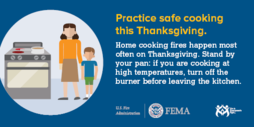
|
 Evacuations from your home or work are more common than many people
realize. FEMA urges residents to know their evacuation routes and to heed the
direction of local officials taking seriously their instructions to evacuate. According to the Ready Campaign, fires and floods cause evacuations most frequently across the U.S.,
and almost every year, people along coastlines evacuate as hurricanes approach.
In addition, hundreds of times per year, transportation and industrial accidents
release harmful substances, forcing many people to leave their homes.
You don’t have to wait for an official evacuation notice to prepare,
you can start now. Contact your local emergency management agency for the evacuation routes in your community.
Additionally, follow these guidelines for evacuation:
Be ready to evacuate yourself and your family with Ready’s Evacuation Guidelines.
|
 As you plan your Thanksgiving menu don’t forget about
fire safety.
Did you know Thanksgiving is the peak day for home
cooking fires? The number of home fires double on Thanksgiving. So, let’s add a
pinch of fire safety to the menu.
Keep these safety tips in mind as you prepare your meal.
Turkey:
If you're roasting your turkey, make sure you set a
timer. This way, you won’t forget about the bird as you watch the parade or a football game.
If you're frying your turkey:
- Use a fryer with thermostat controls. This
will ensure the oil does not become over heated.
- Thaw your turkey completely. Ice on the bird
will cause the oil to splatter.
- Don’t overfill the pot with oil. If you do,
the oil will overflow when you add the turkey causing a fire hazard.
- Keep children and pets at least three feet
away from the fryer.
- Also, always use the fryer outdoors.
Stuffing and Potatoes:
Stand by your stove when you're boiling your potatoes or
frying onions for stuffing. It is best to stay in the kitchen when you're
frying, boiling or broiling. If you're in the kitchen, it is easier to catch
spills or hazardous conditions before they become a fire.
Vegetables:
- Keep the area around the stove clear of
packaging, paper towels, and dish cloths; anything that can burn.
- Be sure to clean up any spills as they
happen.
- Be prepared. Keep a large pan lid or baking
sheet handy in case you need to smother a pan fire.
- Turn pot handles towards the back of the
stove so you don’t bump them.
By following these safety tips,
you will have a delicious and fire safe Thanksgiving. Let the firefighters have
dinner with their families, not yours.
|
 Neighbors
may be the first to help you after a disaster. With that in mind, the City of
Los Angeles Emergency Management Department developed the 5 Steps to
Neighborhood Preparedness. Check out the following links to learn about the 5
steps, how a neighborhood practiced their plan during America’s PrepareAthon!
and how another neighborhood put it into action:
For more information, visit the Los Angeles Emergency Management Department.
|
In observance of National Native
American Heritage Month, FEMA’s Individual and Community Preparedness Division
and the Office of External Affairs, Tribal Affairs will host a webinar on Wednesday,
November 30 from 2:00 to 3:00 p.m. ET focusing on disaster preparedness and
resilience efforts serving tribal communities. You’ll hear several leaders who
have worked to put preparedness into action by developing successful
community-based initiatives and receive related program resources.
Title: Celebrating National Native American Heritage Month
through Community Preparedness
Date: Wednesday, November 30, 2016
Time: 2:00 – 3:00 p.m. Eastern Time (ET)
Featured
Speakers:
- Tim
Zientek, Director of Emergency Management, Potawatomi Nation
- Jeff
Hansen, Director of Emergency Management, Choctaw Nation of Oklahoma
- Hailey
Starr and Sarah Clark, Muckleshoot Tribal School
- Milo Booth,
National Tribal Affairs Advisor, Office
of External Affairs, FEMA
How to Join the Webinar:
We hope that you will be able to join us on November 30!
Put your community on
the road to resilience with the Roadmap to Resilience course (E426) from FEMA’s
Emergency Management Institute. Participants will learn how to develop an
implementation plan in their community, how to establish a community coalition
and approaches that encourage local leaders to augment resilience within the
unique circumstances of their community.
The course will be
conducted December 12-14, 2016, at the National Emergency Training Center in
Emmitsburg, Maryland. It is designed to inspire and provide participants with
information intended to increase a community’s resilience through the whole
community approach to emergency management.
The target audience for
this course includes community stakeholders interested in disaster resilience,
and emergency management professionals with less than three years of experience
who support or implement inclusive emergency management, community disaster
planning, preparedness activities, and community outreach partners at the state
and local levels.
The
deadline date to register is November 21, 2016. Submit a completed
General Admission Application FEMA Form 119-25-1 to
your State Training Officer
(or point of contact). For more information, contact Matthew Lyttle at matthew.lyttle@fema.dhs.gov.
Disclaimer: The reader recognizes that the
federal government provides links and informational data on various disaster
preparedness resources and events and does not endorse any non-federal events,
entities, organizations, services or products. Please let us know about other
events and services for individual and community preparedness that could be
included in future newsletters by contacting citizencorps@fema.dhs.gov.
|

|